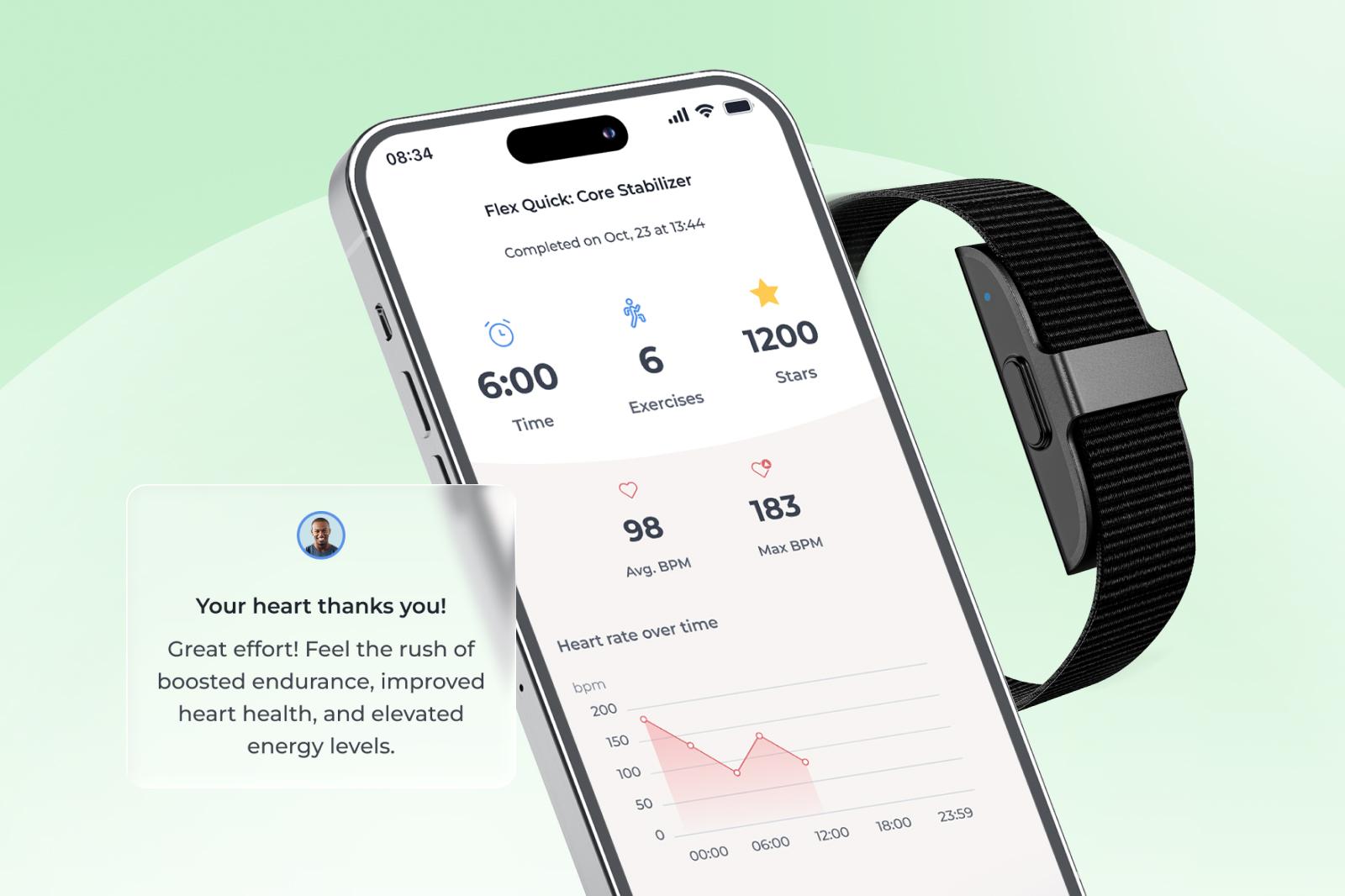August 21, 2025 • min read
How to prevent muscle loss during weight loss
Written by

Head of Clinical Strategy, Sword Move
Muscle loss is the health risk no one talks about during weight loss
Weight loss programs often celebrate the number on the scale. But when that number drops without context, something important can get lost. That something is muscle.
While the goal may be to reduce fat, many weight loss strategies, especially those driven by medication or calorie restriction, also cause lean muscle loss. This isn’t just a side effect, it’s a long-term health risk. Muscle isn’t just about strength or appearance. It’s a critical part of your metabolic system, your functional ability, and your protection against injury. Losing it during weight loss can lead to fatigue, weakness, chronic pain, and mobility challenges, even if the pounds come off. And the risk isn’t theoretical. Clinical research shows that up to 39% of lean muscle mass is lost during GLP-1 medication usage¹. Muscle loss is linked to increased fatigue, a higher risk of falls, MSK conditions, and costly downstream care.
For employers and health plans, this muscle loss can drive up musculoskeletal (MSK) costs in the form of chronic pain claims, fall injuries, and rising disability rates. For individuals, it can mean regaining weight, losing mobility, and feeling worse than when the journey started. Understanding this hidden risk is the first step. Next, let’s explore why muscle matters and how to protect it.
Muscle is more than mass, it’s a long-term health asset
After understanding the risk, we need to reframe how we think about muscle. It isn’t just a side effect of weight training or a cosmetic bonus. Muscle plays a central role in health, especially during weight loss.
Muscle supports metabolism by helping the body burn calories at rest². It protects joints and bones by stabilizing movement and absorbing impact³. It reduces injury risk by improving balance and strength, and it enables everyday function like walking, lifting, and climbing stairs⁴.
When you lose lean muscle during weight loss, you don’t just get lighter, you get weaker. That weakness can set off a chain reaction: lower energy, less movement, more joint stress, and eventually, pain or injury. This is a compounding risk that leads to physical and financial consequences over time. Now that we’ve seen what muscle does for you, let’s break down what causes it to disappear during weight loss.
What causes muscle loss during weight loss?
Many of the most popular weight loss programs contain hidden risks. Calorie restriction or pharmacological appetite suppression may reduce fat, but they also reduce essential lean tissue if not properly supported. Muscle loss is most often triggered by:
- Rapid calorie restriction, which can cause the body to burn muscle for fuel
- Lack of physical activity, especially resistance-based movement
- Inactivity during weight loss, particularly in desk-based or sedentary lifestyles
- Prescription weight loss medications, including GLP-1s like semaglutide, that reduce appetite without supporting movement¹
Without intentional strength training or structured activity, the body sheds both fat and muscle. Most people don’t know this is happening because weight is the only number they’re tracking. Muscle needs to be actively preserved. Let’s look at who is most vulnerable during weight loss journeys.
Who’s most at risk for muscle loss during weight loss?
Some people are more vulnerable than others. Whether due to age, medication, or lifestyle, certain populations lose muscle faster or more significantly during weight loss. Those most at risk include:
- Adults over 40, who naturally lose muscle mass with age (a condition known as sarcopenia)⁵
- People using GLP-1 medications without integrated movement programs¹
- Those with metabolic conditions like prediabetes, insulin resistance, or obesity
- Inactive individuals who sit for most of the day or avoid exercise
- People following aggressive weight loss plans that don’t include strength training
If you or your member population falls into one of these groups, structured movement should be part of any weight loss approach.

The cost of muscle loss to individuals and healthcare systems
Muscle loss has a price tag. It doesn’t just result in fatigue or less strength, it contributes to preventable downstream costs in the form of MSK claims, fall-related ER visits, and disability rates.
Sarcopenia (age-related muscle loss) has been linked to:
- 33% of chronic pain in older adults⁶
- 60% higher fall risk⁷
- 2.5x higher disability risk in those who are both obese and sarcopenic⁸
These clinical risks translate to:
- Increased MSK claim volume
- Longer physical therapy or pain management episodes
- More short-term disability and absenteeism
- Costly long-term disability claims due to functional decline⁹
Muscle loss doesn’t just cost individuals their mobility. It costs health plans and employers in avoidable claims and productivity loss. Fortunately, there’s a way to stop this from happening.
How to prevent muscle loss during weight loss
Preventing muscle loss takes intention. It won’t happen by accident, especially during a weight loss program. But the interventions are simple and proven to work. Here’s how to maintain lean muscle while reducing fat:
Incorporate resistance training
Strength-based movement is the most effective way to preserve — or build — lean mass. Aim for 2–3 sessions per week using bodyweight, resistance bands, or weights¹⁰.
Move consistently throughout the week
Structured movement should be part of every weight loss plan. Look for programs that include personalized routines aligned with your goals and baseline activity level¹¹.
Get enough protein
Protein supports muscle repair and growth. Nutrition matters as much as movement for muscle maintenance.
Avoid overly aggressive calorie restriction
Extreme diets often backfire. A slower, movement-supported approach to fat loss is more sustainable and protects muscle tissue.
Use structured programs with clinical oversight
Programs that offer guidance, tracking, and support deliver better outcomes. This is especially true for GLP-1 users who are losing weight through appetite suppression alone.
Next, let’s look at a structured solution that integrates these principles into one scalable system.
Sword Move: the easy way to prevent muscle loss
 Sword Move is a digital movement program designed to help members stay strong and resilient during weight loss. Move includes:
Sword Move is a digital movement program designed to help members stay strong and resilient during weight loss. Move includes:
- Personalized movement plans guided by a Physical Health Specialist, who holds a Doctorate of Physical Therapy.
- Complimentary wearables or device integration (Apple Watch, Fitbit, etc.)
- Weekly progress tracking and adaptive intensity
- Support for a range of baselines, from inactive to already active users
In real-world populations, the program delivers measurable results:
- 69% of “inactive” and “insufficiently active” members reach “active” or “healthy active” status within 10 weeks¹²
- 4.5 movement sessions per week on average¹³
- Sedentary time reduced by 1 hour 22 minutes per day for previously “inactive” or “insufficiently active” members¹⁴
- 91% of members reported feeling moderately or much better¹⁵
Sword Move supports muscle retention, drives behavioral change, and helps members build sustainable routines.
FAQ: Preventing muscle loss during weight loss
Is it normal to lose muscle while losing weight? Yes, especially without movement or adequate nutrition. But with the right plan, it can be prevented.
Do GLP-1 medications make muscle loss worse? They can. Without structured movement, up to 39% of lean muscle mass may be lost during treatment¹.
What’s the fastest way to protect muscle? Start moving. Resistance training and consistent activity are the most effective strategies available.
Join 500,000+ people using Sword to end their pain
Recover from pain and get moving from the comfort of your home with clinically-proven expert care
Footnotes
Prado CM et al. Muscle matters: the effects of medically induced weight loss on skeletal muscle. The Lancet Diabetes & Endocrinology. 2024;12(11):785–787. https://doi.org/10.1016/S2213-8587(24)00232-7
Wolfe RR. The underappreciated role of muscle in health and disease. American Journal of Clinical Nutrition. 2006;84(3):475–482. https://doi.org/10.1093/ajcn/84.3.475
Leveille SG et al. Chronic musculoskeletal pain and the occurrence of falls in an older population. JAMA. 2009;302(20):2214–2221. https://doi.org/10.1001/jama.2009.1738
Hicks GE et al. Associations between musculoskeletal pain and sarcopenia. Pain Medicine. 2004;5(2):125–134.
Baumgartner RN et al. Epidemiology of sarcopenic obesity. Obesity Research. 2004;12(12):2061–2070. https://doi.org/10.1038/oby.2004.258
Hicks GE et al. Pain Medicine. 2004;5(2):125–134.
Sousa AS et al. Impact of sarcopenia on fall risk: A clinical perspective. Clinical Nutrition ESPEN. 2022;50:63–73. https://doi.org/10.1016/j.clnesp.2022.06.007
Baumgartner RN et al. Obesity Research. 2004;12(12):2061–2070.
Janssen I et al. The healthcare costs of sarcopenia in the United States. Clinical Interventions in Aging. 2017;12:517–528.
American College of Sports Medicine. ACSM's Guidelines for Exercise Testing and Prescription. 11th edition.
Sword Health. Move Program Design Specifications. 2024. Internal data.
Sword Health. MET-min analysis. 2024. Internal dataset.
Sword Health. Move Book of Business, H1 2024. Internal data.
Sword Health. Member reassessment data (5+ weeks). Internal data.
Sword Health. PGIC scores, Sword member base (2023–2024). Internal data.